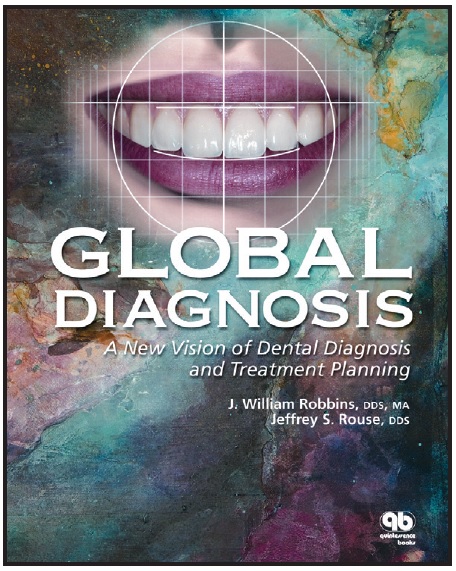BOOK REVIEW
Global Diagnosis: A New Vision of Dental Diagnosis and Treatment Planning
Interdisciplinary dental treatment planning has undergone significant changes since the 1980s, when two prosthodontists, Drs. John Kois and Frank Spear, challenged the conventional model. Because traditional diagnosis had focused on centric relation, preprosthetic orthodontics and restorative treatment started and ended with the condyles. Today, we consider the patient's upper tooth position, rather than just the condylar position. In essence, if the maxillary incisal edges are established correctly in the face, effective function and esthetics will follow. We have seen that principle espoused in the orthodontic teaching of Dr. Thomas Pitts, who uses unconventional bracket positioning to establish a proper smile arc.
This book by Drs. J. William Robbins and Jeffrey S. Rouse expands on the contemporary model to include the upper lip and gingiva. According to the authors, in order to make a "global diagnosis", the restorative dentist and orthodontist must answer five core questions:
- What are the facial proportional and skeletal relationships?
- What are the length and mobility of the upper lip?
- What is the relationship between the gingival line and the horizon?
- What is the length of the maxillary central incisor?
- Is the cementoenamel junction palpable in the gingival sulcus?
Evaluating the bone, lips, gingival margin, incisors, and gingival sulcus helps determine the new incisal-edge position of the maxillary anterior teeth as the starting point in diagnosis.
Of all the books I have read on interdisciplinary treatment planning, this is by far the most heavily focused on the role of the orthodontist. Chapters 6-8 cover the critical issues of interdisciplinary orthodontics, including dentoalveolar intrusion, forced eruption, and orthognathic surgery. Still, I particularly appreciated the sections that are only indirectly related to orthodontics. For example, chapter 4 reviews esthetic crown-lengthening surgery, offering invaluable guidance on when to refer for a flap and alveolar recontouring. Chapter 9 covers the emerging field of dental facial plastics, such as Botox and dermal fillers. The entire text is wonderfully written and easy to follow, and virtually every page contains high-quality professional photography, often showing patients in braces.
Interdisciplinary orthodontics is given only a brief overview in residency. In the real world, we are forced to proceed by trial and error - and often retreatment - until we develop systems to improve our efficiency and the quality of our finishes. Treatment lumbers as we fight for each degree of root uprighting or millimeter of bodily intrusion. Why must interdisciplinary treatment be such a cobblestone road? Perhaps it is time to reevaluate how we diagnose and treat these patients, following the lead of Drs. Robbins and Rouse. If you were to own only one book on interdisciplinary treatment, this would be a great one.
NEAL D. KRAVITZ, DMD, MS
Similar articles from the archive:


